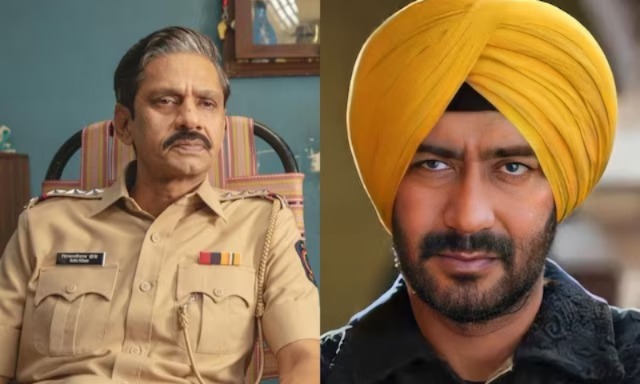The world of Bollywood is no stranger to controversies, especially when it involves well-known actors and high-profile projects. Recently, the news of Vijay Raaz being removed from the much-anticipated sequel “Son of Sardaar 2” has created quite a stir in the industry. The reasons cited include ‘worse’ behavior on the sets, leading to tensions between Raaz and the film’s lead actor, Ajay Devgn. Vijay Raaz, known for his unique and compelling performances, has responded to the allegations by claiming that the real issue was something far more trivial – his failure to greet Ajay Devgn on set. This incident opens up a broader conversation about the dynamics of the film industry, the pressures actors face, and the fine line between professional decorum and creative expression. Vijay Raaz is a seasoned actor in the Indian film industry, celebrated for his versatility and ability to bring depth to a wide range of characters. From his iconic role in “Run” to his memorable performances in “Delhi Belly” and “Gully Boy,” Raaz has established himself as a reliable and talented actor. His presence in any film is often a guarantee of quality, particularly in the character actor space. “Son of Sardaar 2” is the sequel to the 2012 hit “Son of Sardaar,” a film that combined action and comedy, starring Ajay Devgn, Sonakshi Sinha, and Sanjay Dutt. The first film was a commercial success, praised for its entertaining storyline and strong performances. The sequel, therefore, carries high expectations, with fans eagerly awaiting the return of their favorite characters. Reports emerged that Vijay Raaz was abruptly removed from “Son of Sardaar 2” due to what was described as ‘worse’ behavior. While the details were initially vague, sources from the set hinted at unprofessional conduct that created an uncomfortable atmosphere for the cast and crew. The situation quickly escalated, leading to the decision to remove Raaz from the film. However, Vijay Raaz has offered his side of the story, painting a different picture of the events that transpired. According to Raaz, the crux of the issue was his failure to greet Ajay Devgn when he arrived on set. Raaz claims that this perceived slight was blown out of proportion, leading to his removal from the project. He expressed his bewilderment over the situation, stating, “I didn’t greet Ajay Devgn on set, and that’s why this whole thing happened. It was not intentional, and I never imagined something so small would lead to this.” This incident sheds light on the complex power dynamics that exist within the Bollywood industry. The relationship between actors, especially when it involves a star like Ajay Devgn, and supporting cast members can be fraught with expectations and unspoken rules. The issue of respect and professional decorum is paramount, but the lines can often be blurred. In Bollywood, where seniority and stardom often dictate behavior on set, a perceived lack of respect can lead to significant repercussions. This is not the first time such an issue has surfaced; the industry has a long history of conflicts arising from similar misunderstandings or differences in expectations. The question then arises: was Vijay Raaz’s removal justified, or was it an overreaction rooted in the hierarchical nature of Bollywood?
Vijay Raaz REMOVED from Son of Sardaar 2 Over ‘Worse’ Behaviour; He Claims ‘I Didn’t Greet Ajay Devgn…’
Vijay Raaz’s situation also highlights how easily relationships in the industry can sour, especially when navigating the egos and sensitivities of major stars. While Ajay Devgn is known for his professionalism, the incident suggests that even small actions (or inactions) can have significant consequences. Being removed from a high-profile project like “Son of Sardaar 2” could have serious implications for Vijay Raaz’s career. In an industry where reputation and perception play crucial roles, such incidents can affect future opportunities. Raaz, known for his dedication to his craft, may find himself facing challenges in securing roles, especially in films with big stars or under major production banners. However, Raaz’s response to the situation has been measured. Instead of lashing out or engaging in a public spat, he has expressed his confusion and disappointment without casting blame. This approach might help him maintain his dignity and professionalism in the eyes of industry insiders and audiences alike. The incident also raises questions about the treatment of character actors in Bollywood. While they play pivotal roles in films, they often do not receive the same level of respect or consideration as leading stars. Vijay Raaz’s experience could be seen as symptomatic of a broader issue within the industry, where the contributions of character actors are undervalued, and they are expected to conform to the whims of the more powerful stars. The removal of Vijay Raaz from “Son of Sardaar 2” has sparked a range of reactions, both within the industry and among the public. Fans of Raaz, in particular, have expressed their disappointment on social media, questioning the fairness of the decision. Many believe that his talent should be the focus, not the perceived slight against a senior actor. Industry insiders have been more cautious in their responses. While some have defended Ajay Devgn and the production team’s decision, citing the importance of maintaining discipline on set, others have sympathized with Raaz, acknowledging the pressures that come with working in such a hierarchical environment. The incident has also led to a broader discussion about the culture of Bollywood, where power imbalances can lead to such conflicts. Some have called for a more equitable treatment of all actors, regardless of their standing in the industry, emphasizing that respect should be mutual and not just one-way. This controversy brings to the fore the ongoing debate about the treatment of actors within the Bollywood system. While the industry is known for its glamour and success, the behind-the-scenes realities can be quite different. The incident between Vijay Raaz and Ajay Devgn underscores the challenges actors face in navigating the industry’s complex social dynamics.
